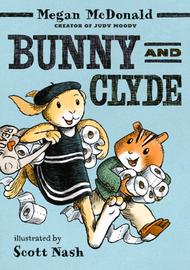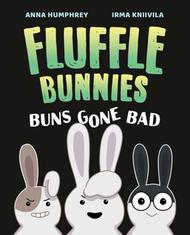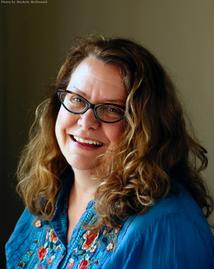
|

|
Megan McDonald is the author of the popular Judy Moody and Stink series and has written many other chapter books and picture books for children. She lives in California. Bunny and Clyde was published by Candlewick in March 2024.
Anna Humphrey is the author of the Megabat and Clara Humble series. She lives in a big, old brick house in Kitchener, Ontario. Fluffle Bunnies: Buns Gone Bad was published May 2024 by Tundra Books.
Here, McDonald and Humphrey discuss writing mischief for kids, the excitement of working with artists who understand the vision, and historical bad bunnies.
Megan McDonald: When I read Fluffle Bunnies, I knew we were going to be friends! Why did you want to write about bad bunnies?
Anna Humphrey: A few years ago, my son came running to tell me he'd found a secret nest of baby bunnies. We live across from an elementary school, and the mother rabbit decided to have her babies at the base of a "bus loading zone" sign. "Kind of a poor choice, Mama," I thought, but then I did some research.
It turns out mother rabbits aren't exactly the nurturing types. They nurse their babies twice a day, but the rest of the time they stay far away from the nest to avoid attracting predators. Then I wondered if maybe this Mama was on to something! She hid her babies in plain sight where almost nobody saw them. CUNNING! Then she tough-loved them into learning how to fend for themselves. Almost like she was preparing them to be bunnies who could take on the world--perhaps even take it over? And that's how the Fluffle Bunnies began.
McDonald: So, it's true, then, that a Mama bunny might run off to Brazil to become a jujitsu master.
Humphrey: It is! But tell me all about how Bunny and Clyde came to be--I am dying to know.
McDonald: Usually, my books are inspired by an experience, like yours. But in this case, it was really the names of the characters that inspired me: I scribbled "Bunny and Clyde" down on a napkin years ago. Their names, of course, are a riff on Bonnie and Clyde, who were famous bank robbers. So, I decided I wanted my characters to be bad. I think it's tantalizing for kids to read about a character who does something bad. But I thought it might be funny if they've always been good, and don't know how to be bad--so, they have to learn.
Humphrey: I love that as a concept. I was such a rule follower as a kid. What inspired you to make Clyde something other than a bunny?
McDonald: At first, I made both of my main characters bunnies. Bunny had to be a bunny, right? But then I thought it might be harder to distinguish between them, so I turned Clyde into a chipmunk. I love the visual contrast. I originally started the book by stating that there were two bad bunnies. Except one wasn't a bunny. So, then I got some humor out of people calling them bunnies and Clyde protesting that he's a chipmunk.
Bunnies are so sweet and cuddly, I think it's fun to flip the script and think of them as "bad" guys. In Bunny and Clyde, they try so hard to be bad, but everything keeps turning out good.

|
|
| Anna Humphrey (photo: Christine Saunders) |
|
Humphrey: Agreed. There's just something so timelessly funny about a creature that's so cute behaving badly. I didn't realize before I started writing Fluffle Bunnies that bad buns are actually a tale as old as time. They even appear in the margins of medieval manuscripts! All these cute little bunnies wielding spears and chopping off heads. Obviously, my bunnies weren't going to do that... but rabbits really are big-time trouble. Ask a gardener. Or any rabbit owner.
McDonald: Yes, I once had a rabbit named Nutmeg and she would escape and build nests out of clothes, pillow stuffing, shoes....
Humphrey: They are pure mischief.
McDonald: Mischief is a good word. Why did you make your bunnies bad in the ways you did?
Humphrey: After their mom hops off to become a jujitsu master in Brazil, I wanted readers to see the bunnies not just survive but thrive. But to accomplish that, they could only work with what they had. That's why whether they're outsmarting racoon goons or thwarting evil chipmunks (Sorry, Clyde!), they do it with brains, and, of course, the incredible power of their cuteness.
McDonald: I love that they are so clever and ingenious.
Humphrey: It was so much fun to watch Bunny and Clyde's bad deeds get foiled at every turn. How do you depict "bad" animals for the youngest readers without totally glamorizing a life of crime or bad behavior?
 |
|
| Megan McDonald |(photo: Michele McDonald) |
|
McDonald: A lot of books about being bad or good are overly instructive and didactic. I think it's more fun if kids can see themselves in a character who has flaws and is not good all the time. Kids can relate to not always wanting to clean your room, or return your library book on time, or compost those apple cores.
In my book, I tried to get across a whiff of danger, a taste of being bad, but then it turns out that crime doesn't pay. Hey, I think I just thought of the next adventure: Bunny and Clyde: Crime Doesn't Pay!
Humphrey: Ahhhh! So honored to be here to witness that.
I definitely found this to be a tricky balance. I don't want to be promoting badness... but there's a difference between being bad-bad and being bad in the sense that you're brash and bold. Standing up for myself is something I really struggled with as a kid, and something I'm still learning to do. I've got a thing or two left to learn from my bunnies. Biggie, Boingy, and Flop are always reaching high and looking out for numbers one, two, and three, but they're never malicious. If another character feels their adorable wrath, you can bet they did something to deserve it.
McDonald: I agree, it is a tricky balance, and I think adults worry about promoting something that we deem as "bad" behavior. But kids accept and laugh at it. Maybe it goes back to your word: mischief. A little mischief is not a bad thing.
Humphrey: I'm a big fan of shenanigans.
McDonald: Another great word! When I read Bunny and Clyde aloud to a class of third graders, they kept shouting out, "They're good! No, they're bad! They're good again!" They seemed to delight in recognizing and anticipating what might be thought of as bad behavior.
Your book is so funny, and the humor is enhanced by the visuals. How did you convey your humor to the illustrator?
Humphrey: Writing a graphic novel turned out to be a lot like writing a play with stage directions and character descriptions. I tried my best to convey the ridiculousness going on in my head, and thankfully Irma Kniivila didn't need much help ramping up the humor. She's naturally ridiculous (and I mean that in the best way possible)! Her take on the buns delighted me--I feel so lucky to work with her.
McDonald: It's exciting when the illustrator adds so much to the work. Scott Nash, the illustrator of Bunny and Clyde, thought of the WANTED poster, for example.
So, might there be another Fluffle Bunnies in our future?
Humphrey: There will. Working title is Big City Buns. How about Bunny and Clyde?
McDonald: Book two is also in the works: Bunny and Clyde: On the Lam.
This has been so much fun. I hope we both get up to some shenanigans in the future!
Anna: Definitely! Mischief and mayhem await.

